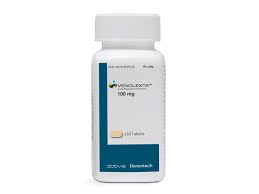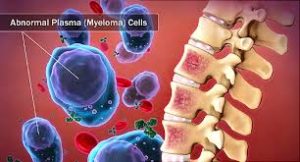
Recently Diagnosed or Relapsed? Stop Looking For a Miracle Cure, and Use Evidence-Based Therapies To Enhance Your Treatment and Prolong Your Remission
Multiple Myeloma an incurable disease, but I have spent the last 25 years in remission using a blend of conventional oncology and evidence-based nutrition, supplementation, and lifestyle therapies from peer-reviewed studies that your oncologist probably hasn't told you about.
Click the orange button to the right to learn more about what you can start doing today.
- You are here:
- Home »
- Blog »
- Multiple Myeloma »
- Relapsed/Refractory Multiple Myeloma- t11/14 enhances Ventoclax?
Relapsed/Refractory Multiple Myeloma- t11/14 enhances Ventoclax?

It sounds counterintuitive that an t11/14 seems to be a good thing for relapsed/refractory multiple myeloma survivors. But maybe…
When you were diagnosed with multiple myeloma, FISH analysis determined that you had a genetic abnormality- a t11/14 or 11/14 translocation. You thought this meant that your MM was more difficult to treat. So when you became relapsed/refractory you weren’t surprised.
Don’t misunderstand me. Relapsed/refractory multiple myeloma is not only difficult to treat but can mean that you are running out of options to manage your MM.
After years of treatment, toxicity, side effects, etc. you may be getting tired. Your MM is wearing you out.
According to the study linked and excerpted below, your t11/14 increases the likelihood of your relapsed/refractory MM responding to the triplet chemo cocktail ventoclax, bortezomib (velcade) and dexamethasone (VVd).
Before you jump for joy or rush to schedule an appointment with your oncologist, keep in mind that the study below does not discuss the side effects aka adverse events experienced by the trial group. Yes, the group of MM patients responded well to VVd but a what cost?
Also keep in mind that if you have already undergone 1-3 different types of chemotherapy, your body will probably be exhausted from all the previous toxicity. Consider complementary therapies to boost your immune function such as moderate exercise, yoga, whole-body hyperthermia, massage, others.
I have linked websites listing the side effects aka adverse events of both ventaclax as well as velcade below. It is possible that the combination of these two toxic therapies could worsen common side effects. Further, if your body is already wracked with previous chemotherapy, you may be more susceptible to yet another chemotherapy triplet.
My apologies for being a bit of a Debby Downer. I believe an ounce of prevention is worth a pound of cure.
Have you become relapsed/refractory? Are you t11/14? Scroll down the page, post a question or comment and I will reply to you ASAP.
To Learn More About Relapsed/Refractory Myeloma- click now
Hang in there,
David Emerson
- MM Survivor
- MM Coach
- Director PeopleBeatingCancer
Recommended Reading:
- Relapsed/Refractory Multiple Myeloma- Cytogenetic Testing- Options
- Side-Effects Change Multiple Myeloma Patient Decision-Making…
- Clinical Trial Chemo Comparison for Multiple Myeloma-A to A
Phase III Study With Venetoclax Combo Identifies New Biomarker for Relapsed/Refractory Myeloma
“The phase III BELLINI trial (NCT02755597) demonstrated translocation(t)(11;14) and high BCL2 gene expression are predictive of response to treatment with the addition of venetoclax (Venclexta) to bortezomib (Velcade) plus dexamethasone in patients with relapsed/refractory multiple myeloma…
Moreover, the triplet regimen led to promising response rates in patients with relapsed/refractory myeloma…
In the venetoclax arm,
- 61% of patients achieved a very good partial response (VGPR) or better,
- 29% achieved a complete response (CR) or better, and
- 13% of patients achieved minimal residual disease (MRD)-negativity
versus 40%, 7%, and 1% in the placebo arm, respectively…
In the t(11;14) subgroup, venetoclax induced a
- 95% ORR,
- including a ≥VGPR of 75% of patients,
- a ≥CR of 55%, and
- MRD-negativity in 25%
versus 47%, 27%, 7%, and 0% with placebo, respectively…
The randomized double-blind, multicenter phase III BELLINI trial evaluated the efficacy of adding venetoclax to bortezomib plus dexamethasone compared with placebo and bortezomib plus dexamethasone in patients who received 1 to 3 prior lines of therapy and were either sensitive or naïve to proteasome inhibitors (PIs)…
Patients also had to have received 1 to 3 prior lines of therapy, which could include prior bortezomib or another PI. However, patents were not included if they became refractory to a prior PI, received a PI treatment within 60 days of the first dose of the study drug…
Venetoclax is a highly selective and potent oral BCL-2 inhibitor, which can induce apoptosis and has synergistic activity with bortezomib plus dexamethasone. Previous phase I data demonstrated encouraging clinical efficacy with the triplet regimen in patients with t(11;14) multiple myeloma, as well as in a broader population of patients with myeloma…”
Venetoclax Side Effects
“In Summary- Commonly reported side effects of venetoclax include: tumor lysis syndrome and neutropenia. See below for a comprehensive list of adverse effects…”
Bortezomib Side Effects
“Along with its needed effects, bortezomib may cause some unwanted effects. Although not all of these side effects may occur, if they do occur they may need medical attention.




